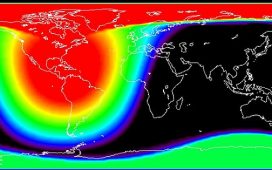The government has given the final go-ahead to India’s Laser Interferometer Gravitational-Wave Observatory, or LIGO, project, clearing the way for the construction of the country’s biggest scientific facility that will join the ongoing global project to probe the universe by detecting and studying gravitational waves.
LIGO is an international network of laboratories that detect the ripples in spacetime produced by the movement of large celestial objects like stars and planets. These ripples were first postulated in Albert Einstein’s General Theory of Relativity that encapsulates our current understanding of how gravitation works.
LIGO-India will be located in Hingoli district of Maharashtra, about 450 km east of Mumbai, and is scheduled to begin scientific runs from 2030. Here’s what you need to know about gravitation, Einstein’s General Theory of Relativity, and the purpose and significance of the LIGO project.
Newton’s law of gravitation
Almost everyone with a high-school background would be familiar with Newton’s law of gravitation. The English mathematician Sir Issac Newton (1643-1727) had postulated that the force that makes any object fall to the ground was also the one that makes heavenly bodies go around in their orbits.
Newton proposed that this was due to the fact that every celestial body exerted an attractive force on every other body in the universe. He worked out a mathematical formulation to calculate the strength of this attractive force which, he found, was directly proportional to the masses of the two bodies and inversely proportional to the square of the distance between them.
For more than two centuries, this remained the best understanding of gravitation. It could explain the motion of all celestial objects, and the mathematical framework was able to produce results that matched precisely with the observations. Newton’s law of gravitation is an integral part of elementary science education even today, and its mathematics continues to be applied in a wide variety of modern-day scientific investigations with a remarkable degree of accuracy.
Deficiencies in Newton’s law
Its success notwithstanding, the theory suffered from a couple of major deficiencies, one of which was evident even during Newton’s time. Newton himself acknowledged it while describing the gravitational force in his landmark publication, The Mathematical Principles of Natural Philosophy in 1687, and his contemporaries were aware of it. The theory did not explain the reason for the existence of the attractive force between any two bodies. Why should every piece of matter feel attracted towards everything else?
The second problem became apparent much later, at the start of the 20th century, as a consequence of Albert Einstein’s Special Theory of Relativity. Special Relativity, published in 1905, established that nothing could travel faster than the speed of light. But the gravitational force seemed to be propagating instantaneously, over any large distance, without any delay at all. Time does not even figure in Newton’s gravitational equation.
General Theory of Relativity
Ten years later, in 1915, Einstein altered our understanding of gravitation with his General Theory of Relativity. He had already shown, with Special Relativity, that space and time were not independent entities but had to be woven together as spacetime. With General Relativity, which was essentially a new theory of gravitation, Einstein took a huge leap of thought.
He proposed that spacetime was not just a passive backdrop to the events happening in the universe. It was not a mere transparent, inert, and static stage. Instead, spacetime interacted with matter, was influenced by it, and in turn, itself influenced events. It was like a soft fabric that responds to a heavy object placed on it, and curls around it.
The curvature in spacetime so produced was the reason other smaller bodies in the vicinity felt the gravitational pull. In fact, there is no force at all. Gravitation is just the curvature in spacetime. Since the spacetime itself is curved around the heavier mass, other nearby objects, moving normally in straight lines in their spacetime, find themselves going around the central mass. The heavier the mass in the centre, the steeper and bigger is the curvature in spacetime, and stronger and more extended is the gravitational field.
With one mind-bending idea, Einstein was able to explain the origin of the gravitational force, and also the reason for perpetual, near-circular, motion of all heavenly bodies. As physicist John Wheeler described very succinctly, matter tells spacetime how to curve and spacetime tells matter how to move. Also, this model of gravity does not involve instantaneous propagation of force. The experience of a pull towards the central mass happens at the speed of light.
Gravitational waves
General Relativity also predicted that moving objects would generate gravitational waves in spacetime, just like a moving boat produces ripples in water. Because these are ripples in spacetime itself, gravitational waves have the effect of causing a temporary deformation in a body when it comes in contact. Since the spacetime itself elongates or contracts during the propagation of the gravitational wave, everything lying in that spacetime also goes through the same experience.
This effect is similar to a ball being slightly squeezed along any of its diameters. The ball flattens a bit in the direction of pressure that is applied, while it bulges out in the perpendicular direction. When a gravitational wave passes the Earth, for example, the Earth gets similarly squeezed in one direction, and bulges in the perpendicular direction.
Because gravity is the weakest of all natural forces, the deforming effect of gravitational waves is extremely tiny, the reason why it could not be experimentally verified for 100 years even though many other predictions of General Relativity were tested repeatedly during this period.
How LIGO works
It is to measure these tiny effects of gravitational waves that scientists have set up the Laser Interferometer Gravitational Wave Observatory (LIGO), one of the most complex pieces of scientific equipment ever built. The observatory comprises two 4-km-long vacuum chambers, built perpendicular to each other. Highly reflective mirrors are placed at the end of the vacuum chambers.
Light rays are released simultaneously in both the vacuum chambers. They hit the mirrors, get reflected, and are captured back. In normal circumstances, the light rays in both the chambers would return simultaneously. But when a gravitational wave arrives, one of the chambers gets a little elongated, while the other one gets squished a bit. In this case, light rays do not return simultaneously, and there is a phase difference. The presence of a phase difference marks the detection of a gravitational wave.
The precision of the measurements required to detect gravitational waves is mind-boggling. At a 4-km scale, the changes in distance that light has to travel because of the gravitational wave are 10,000 times smaller than the width of the proton, and LIGO instruments are designed to pick this up. According to the LIGO website, this is similar to measuring the distance to a neighbouring star 4.2 light years away with an accuracy smaller than the width of human hair.
The first ever detection of a gravitational wave happened on September 14, 2015, by the two US-based LIGO detectors. These gravitational waves were produced by the merger of two black holes, which were about 29 and 36 times the mass of the Sun, 1.3 billion years ago. Black hole mergers are the source of some of the strongest gravitational waves. But even these are extremely feeble to detect. Scientists checked the results for four months before announcing their result in February 2016.
This achievement was promptly rewarded with the Nobel Prize in 2017. Since then, nine more gravitational wave events have been detected by the four observatories in the United States, Europe and Japan.
Why LIGO India matters
LIGO India, for which the government approval was given on Thursday, would be the fifth node of this international network of gravitational wave observatories, and possibly the last. The instruments at these observatories are so sensitive that they can easily get influenced by events like earthquakes, landslides, or even the movement of trucks, and produce a false reading. That is why multiple observatories are needed to revalidate the signals.
The chances of two observatories, located in different geographies, producing the exact same false reading are negligible. But two detectors are the bare minimum. More are needed to tap all possible sources of gravitational waves, and to improve the quality and accuracy of information. The LIGO website indicates that the India detector, the fifth node in the international network, could be all that is required for the time being.
For India, LIGO is a momentous milestone. India has been an active collaborator in a number of international science projects. These include the Large Hadron Collider experiments, and ITER, the effort to create a thermonuclear reactor that would enable controlled nuclear fusion reactions. India is also expected to be a partner country in setting up the next space station after the current International Space Station comes to the end of its life later this decade.
However, India has not yet built a cutting-edge scientific facility on this scale on its own soil, something that can have huge spin-off benefits for its science and technology sector. The India-based Neutrino Observatory, one such facility that has been planned in India, has been facing delays. LIGO, therefore, is crucial to demonstrating India’s intent and capability to pull-off complex science projects on its own.











